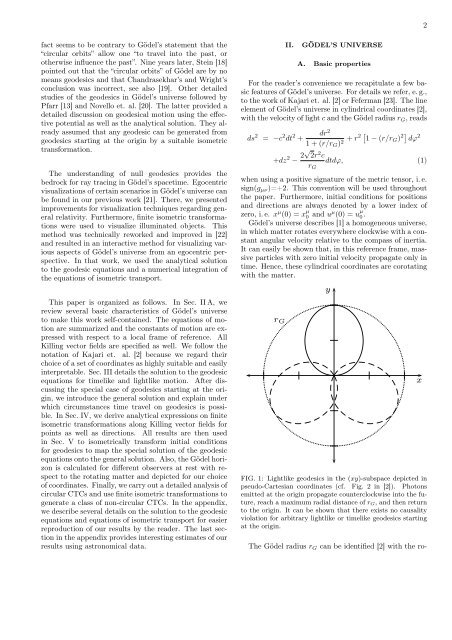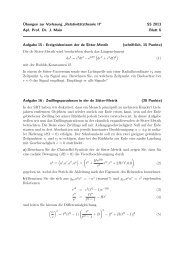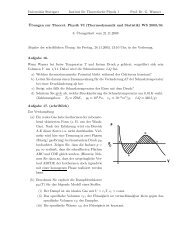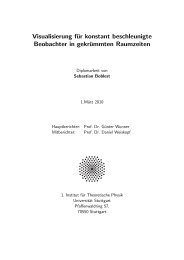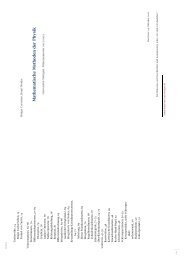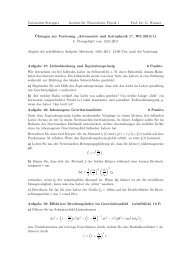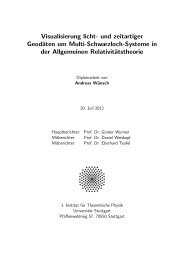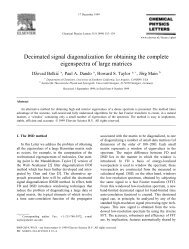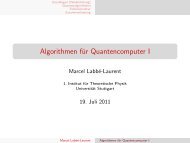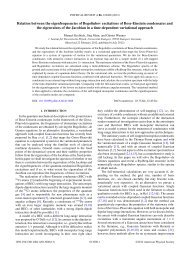The Gödel universe - Institut für Theoretische Physik der Universität ...
The Gödel universe - Institut für Theoretische Physik der Universität ...
The Gödel universe - Institut für Theoretische Physik der Universität ...
Create successful ePaper yourself
Turn your PDF publications into a flip-book with our unique Google optimized e-Paper software.
fact seems to be contrary to <strong>Gödel</strong>’s statement that the<br />
“circular orbits” allow one “to travel into the past, or<br />
otherwise influence the past”. Nine years later, Stein [18]<br />
pointed out that the “circular orbits” of <strong>Gödel</strong> are by no<br />
means geodesics and that Chandrasekhar’s and Wright’s<br />
conclusion was incorrect, see also [19]. Other detailed<br />
studies of the geodesics in <strong>Gödel</strong>’s <strong>universe</strong> followed by<br />
Pfarr [13] and Novello et. al. [20]. <strong>The</strong> latter provided a<br />
detailed discussion on geodesical motion using the effective<br />
potential as well as the analytical solution. <strong>The</strong>y already<br />
assumed that any geodesic can be generated from<br />
geodesics starting at the origin by a suitable isometric<br />
transformation.<br />
<strong>The</strong> un<strong>der</strong>standing of null geodesics provides the<br />
bedrock for ray tracing in <strong>Gödel</strong>’s spacetime. Egocentric<br />
visualizations of certain scenarios in <strong>Gödel</strong>’s <strong>universe</strong> can<br />
be found in our previous work [21]. <strong>The</strong>re, we presented<br />
improvements for visualization techniques regarding general<br />
relativity. Furthermore, finite isometric transformations<br />
were used to visualize illuminated objects. This<br />
method was technically reworked and improved in [22]<br />
and resulted in an interactive method for visualizing various<br />
aspects of <strong>Gödel</strong>’s <strong>universe</strong> from an egocentric perspective.<br />
In that work, we used the analytical solution<br />
to the geodesic equations and a numerical integration of<br />
the equations of isometric transport.<br />
This paper is organized as follows. In Sec. II A, we<br />
review several basic characteristics of <strong>Gödel</strong>’s <strong>universe</strong><br />
to make this work self-contained. <strong>The</strong> equations of motion<br />
are summarized and the constants of motion are expressed<br />
with respect to a local frame of reference. All<br />
Killing vector fields are specified as well. We follow the<br />
notation of Kajari et. al. [2] because we regard their<br />
choice of a set of coordinates as highly suitable and easily<br />
interpretable. Sec. III details the solution to the geodesic<br />
equations for timelike and lightlike motion. After discussing<br />
the special case of geodesics starting at the origin,<br />
we introduce the general solution and explain un<strong>der</strong><br />
which circumstances time travel on geodesics is possible.<br />
In Sec. IV, we <strong>der</strong>ive analytical expressions on finite<br />
isometric transformations along Killing vector fields for<br />
points as well as directions. All results are then used<br />
in Sec. V to isometrically transform initial conditions<br />
for geodesics to map the special solution of the geodesic<br />
equations onto the general solution. Also, the <strong>Gödel</strong> horizon<br />
is calculated for different observers at rest with respect<br />
to the rotating matter and depicted for our choice<br />
of coordinates. Finally, we carry out a detailed analysis of<br />
circular CTCs and use finite isometric transformations to<br />
generate a class of non-circular CTCs. In the appendix,<br />
we describe several details on the solution to the geodesic<br />
equations and equations of isometric transport for easier<br />
reproduction of our results by the rea<strong>der</strong>. <strong>The</strong> last section<br />
in the appendix provides interesting estimates of our<br />
results using astronomical data.<br />
II. GÖDEL’S UNIVERSE<br />
A. Basic properties<br />
For the rea<strong>der</strong>’s convenience we recapitulate a few basic<br />
features of <strong>Gödel</strong>’s <strong>universe</strong>. For details we refer, e.g.,<br />
to the work of Kajari et. al. [2] or Feferman [23]. <strong>The</strong> line<br />
element of <strong>Gödel</strong>’s <strong>universe</strong> in cylindrical coordinates [2],<br />
with the velocity of light c and the <strong>Gödel</strong> radius rG, reads<br />
ds 2 = −c 2 dt 2 +<br />
dr 2<br />
1 + (r/rG) 2 + r2 1 − (r/rG) 2 dϕ 2<br />
+dz 2 − 2√2r2c dtdϕ, (1)<br />
rG<br />
when using a positive signature of the metric tensor, i.e.<br />
sign(gµν)=+2. This convention will be used throughout<br />
the paper. Furthermore, initial conditions for positions<br />
and directions are always denoted by a lower index of<br />
zero, i.e. x µ (0) = x µ<br />
0 and uµ (0) = u µ<br />
<strong>Gödel</strong>’s <strong>universe</strong> describes [1] a homogeneous <strong>universe</strong>,<br />
in which matter rotates everywhere clockwise with a constant<br />
angular velocity relative to the compass of inertia.<br />
It can easily be shown that, in this reference frame, massive<br />
particles with zero initial velocity propagate only in<br />
time. Hence, these cylindrical coordinates are corotating<br />
with the matter.<br />
rG<br />
y<br />
FIG. 1: Lightlike geodesics in the (xy)-subspace depicted in<br />
pseudo-Cartesian coordinates (cf. Fig. 2 in [2]). Photons<br />
emitted at the origin propagate counterclockwise into the future,<br />
reach a maximum radial distance of rG, and then return<br />
to the origin. It can be shown that there exists no causality<br />
violation for arbitrary lightlike or timelike geodesics starting<br />
at the origin.<br />
<strong>The</strong> <strong>Gödel</strong> radius rG can be identified [2] with the ro-<br />
0 .<br />
x<br />
2


